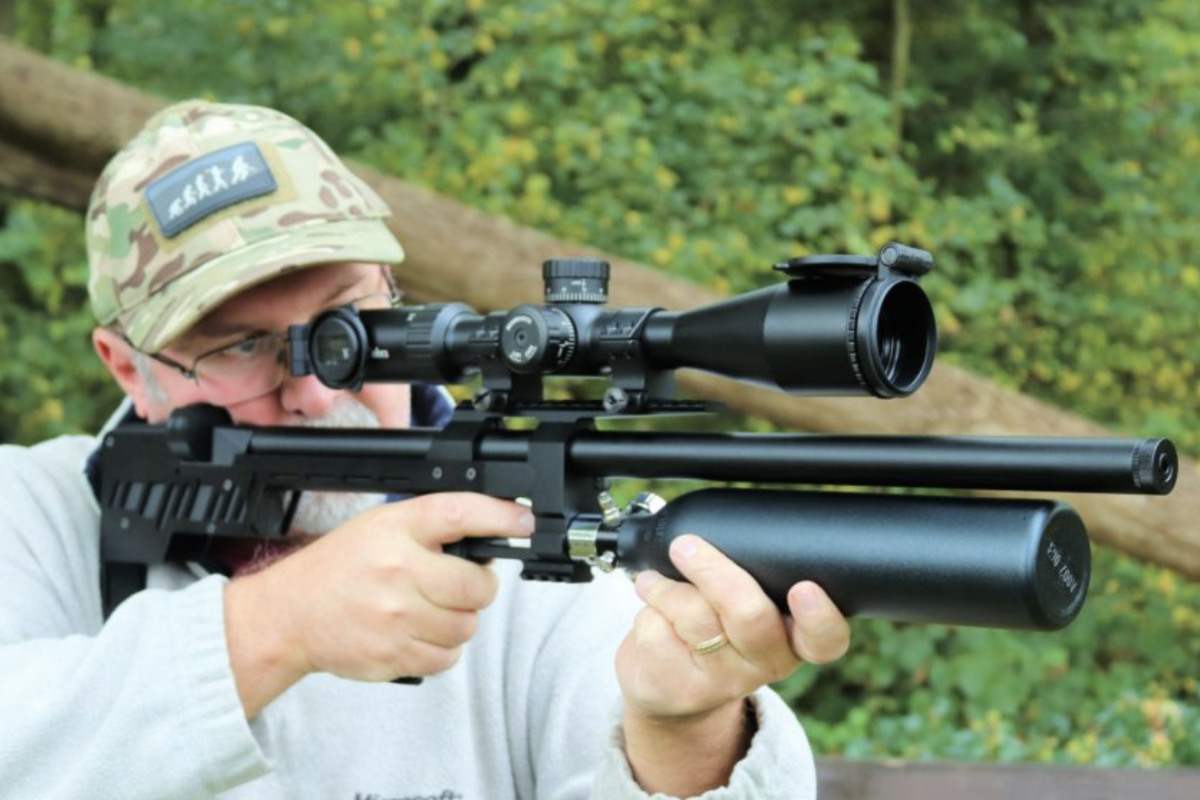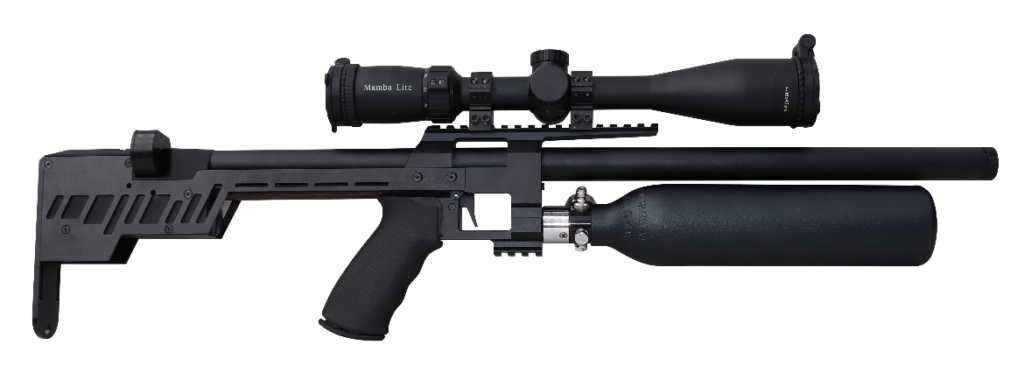RTI Arms Priest 2
Richard Saunders finds out whether the RTI Arms Priest 2 is hellbent or heaven-sent.

RTI Arms Priest 2
For a long time, a small group of established manufacturers have dominated our sport: companies whose reputations date back decades to when springers where the only game in town, joined by those who led the PCP revolution.
Today, the world is much smaller and the increasing popularity of airgunning, combined with the wealth of information and communication made possible by the internet, has opened our eyes to products from just about every corner of the world.
And you know what, most of them are pretty good – and a few are much better than that. Eastern Europe seems to have emerged as a hotbed for air rifle manufacturers.
Companies in Ukraine, Turkey, Czech Republic and many more countries that we were ignorant of only a few years ago are now challenging the might of the establishment.
One of the most exciting rifles to emerge is the Priest from RTI Arms – a small Slovenian company that not only produces an excellent rifle, but laudably also employs people with disabilities to make them.
The first Priest was introduced around two years ago. The mark two, which differs in its release valve on the air bottle, redesigned magazine, downward slot to set the bolt when cocked and a more adjustable trigger, is now in production.
For a small company keeping up with demand is a constant challenge, especially as the retail price is a very competitive £900. A win at this year’s Extreme Benchrest event in the USA is likely to increase demand, although the marque’s UK importer, City Air Weapons, says it has good stock of Mk 1 rifles.
RTI Arms Priest 2: key specs

MAKER: RTI Arms
UK DISTRIBUTER: City Air Weapons (www.cityairweapons.com)
MODEL: Priest 2
PRICE: £899.95
TYPE: Bolt-action multi-shot PCP bullpup
CALIBRE: .177, .22, .25 and .30
LENGTH OF PULL: 330mm
BARREL LENGTH: 508mm
WEIGHT: 3kg unscoped, 2.1kg with buddy bottle removed
TRIGGER: Two-stage adjustable
SAFETY: Resettable push-button cross-bolt
FAC POWER: 18 ft-lb in .177, 33 ft-lb in .22, 44 ft-lb in .25 and 66 ft-lb in .30
RTI Arms Priest 2: Stocking up
Writing about the Priest 2’s stock is a little challenging because there isn’t much of one. Very much in the FX Impact style, this rifle takes the tactical look to a new level.
The bullpup configuration means that at just 713mm long without a silencer it is extremely compact – and it’s light too – three kilos. To make the rifle even more portable, you can remove the buddy bottle, hook it to your belt and connect it via a hose to a Foster attachment under the breech. In this configuration the gun weighs just 2.1kg.
The shoulder ‘pad’ is a flat aluminium plate that is rounded at the bottom and measures 138mm long and 33mm wide. It looks like it should be uncomfortable, but it isn’t! Length of pull – the distance from the trigger to the shoulder pad – is 330mm.
An extended stock option is available, however it’s a factory-fit item as the standard butt plate is held on with anti-tamper fixings to prevent access to the regulator and hammer spring. FAC holders can opt to replace the standard regulator with one that is accessible and adjustable, along with a hammer spring screw.
The magazine sits proud of the action, but is off-set so it doesn’t press into your cheek which rests on the fully shrouded barrel – this is far more comfortable than it sounds.
In common with many ultra-tactical bullpups, the bottle doubles up as the fore-stock. You can grip the bottle with your leading hand, or steady the rifle by resting the short Picatinny accessory rail in the heel of your palm and wrapping a couple of fingers around the neck of the bottle where the manometer sits.
The rubberised AR-style pistol grip is contoured and steeply angled. While there’s no capacity to shoot with a thumb-up grip, the set-up is well positioned to access the trigger.
Features and function
Fully adjustable, the trigger has a wide blade that is only slightly curved and feels good on the finger. Out of the box, the first stage is light and comes up against the pronounced resistance of the short second stage. When it breaks though, the let-off is superbly crisp and predictable.
The push button safety catch located behind the trigger does not come on automatically and can be reset. Like everything else with the Priest 2, it feels solid and well-made.
Left-handers are often fobbed off with claims that a rifle is ambidextrous, while in reality they have to suffer a few minor concessions. However, the Priest 2 is, if anything, biased towards southpaws as the straight pull bolt is positioned on the left-hand side of the action, not that righties will find themselves disadvantaged either.
The short, knurled bolt is easy to operate and settles into a shallow slot to let you know you’ve pulled it back far enough. Once raised out of the slot, the bolt handle springs forward gently under slight tension in a militaristic kind of way, though hunters will probably want to ease it back to eliminate the noise.
The bolt slot also ensures the pellet probe at the rear of the action is held back, allowing you to remove and reinstall the magazine, which is made from high-quality plastic. There are 14 shots in .177, 12 in .22, 10 in .25 and seven in .30. Once again, lefties are in for a treat as the magazine can be loaded from either side of the breech.
Unlike many other magazines, there’s no need to pre-load a spring mechanism. Simply put the pellets in nose-first and rotate the magazine clockwise if you intend inserting from the right. If inserting from the other side, turn the magazine round and rotate the drum anti-clockwise.
The magazine locates easily in the breech with an audible click. Then it’s simply a case of pushing the bolt forward into the fire position. There is a little movement in the bolt, but try as I might, I couldn’t get it to rattle no matter how hard I shook.
Filling the Priest 2 with air is straightforward and achieved via a male Foster fitting that doesn’t have a protective cap and is located on the neck of the 320cc bottle alongside the easy-to-read manometer.
The rifle takes a whopping 300 bar fill, which is enough to give a claimed 350 shots in .177 and 500 in .22 at 12 ft-lb, although I don’t really feel comfortable pushing my air fills anywhere near that high – even if the manufacturer says I can.
Like an increasing number of guns right now, the Priest 2 is fitted with a Picatinny rail. At 170mm long, it provides plenty of room to ensure perfect eye relief for your scope and I really liked the fact that I could get away with low mounts and still achieve reasonable eye alignment. A 20 MOA Picatinny rail is also available as an option to avoid running out of elevation.
Too many bullpups end up with the scope too high from the barrel, leading to problems with cant and making holdover and holdunder more complicated than it needs to be. A short rail underneath the trigger guard allows a bipod or torch to be fitted.
Although there’s a ½ inch UNF thread for a silencer, the full-length shroud does an excellent job reducing muzzle crack. Like everything else on the Priest 2, the finish is superb. Provided by CZ, the .177, .22 and .25 models have a 20-inch choked barrel with 12 grooves and a 1 in 17.7 inch twist rate (10 grooves in .25).
The high-powered .30 FAC model has a 20-inch choked Lothar Walter barrel with six grooves and a 1 in 16 inch twist rate. You can swap calibres with the purchase of ‘calibre kits’ that comprise a barrel, pellet probe and shroud cap and a barrel removal tool.
For those who fancy extreme range shooting with an appropriate licence, RTI Arms sells an upgraded .22 Lothar Walther barrel which it claims is capable of shooting 25 grain JSB Monster pellets 100 metres at over 1,000 fps without any loss of stability in flight.
Performance
Testing a rifle you’ve never shot before in strong winds and driving rain is not to be recommended – yet that’s what I had to contend with.
If that wasn’t bad enough, I forgot to take the assortment of pellets I use for testing. However, a quick root around in the car turned up a tin of .177 Air Arms Diabolo Field 4.52.
Setting a target at 30 metres, my expectations weren’t high. However, after less than half a magazine to zero the Priest 2, I shot ten full magazines and hit 5p groups every time. Another brand of pellet might be better, but they’d have to go some way to improve on the AA Diabolo Fields.
Although you’ll need a probe to push the pellets home, the magazine performed faultlessly, as did the bolt action. I had no flyers and even when I pushed the distance out to 40 metres, the groups were extremely tight.
Part of that comes down to the regulated action. Set at 125 bar, the regulator delivered a 30-shot string with a maximum variance of 14 feet per second (fps), with the majority closer than that. Average velocity was 790fps, which equates to 11.64 ft-lb.
Starting with a 220 bar fill, I managed 100 shots before the gauge reached 150 bar – RTI’s claim of 350 shots from a 300 bar is close to the mark.
The trigger lived up to its promise and I soon felt at home, predicting the let-off easily every time. Due to their configuration, bullpup triggers are located some distance from the action and often require complicated rods and linkages to connect everything.
As a result, they can feel vague. Not so with the Priest 2 – a single rod is attached directly to the release mechanism.
After some solid shooting the only things I would change – and they are minor – are that I’d like a slightly bigger handle on the bolt and though it’s not uncomfortable, some kind of cheek rest would be welcome too.
The Priest 2 is a great package, and compared with other bullpups on the market, it’s keenly priced. Like a car, some people are happy to spend on the brand, while the smart people buy one that’s just as good, if not better, and costs half the price.








